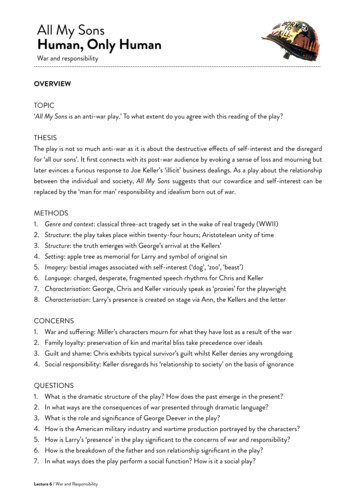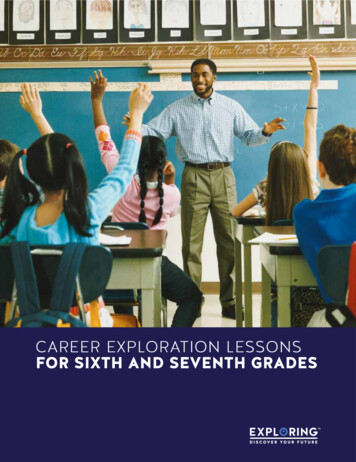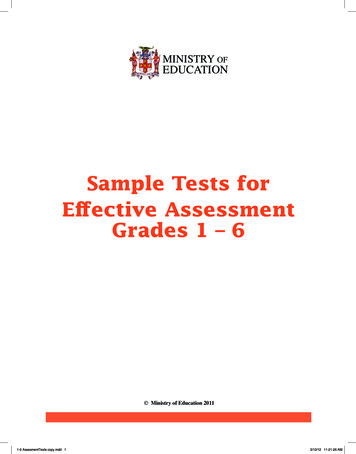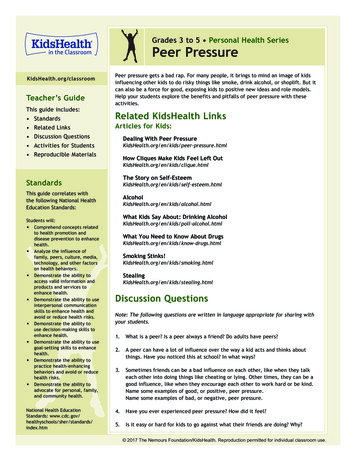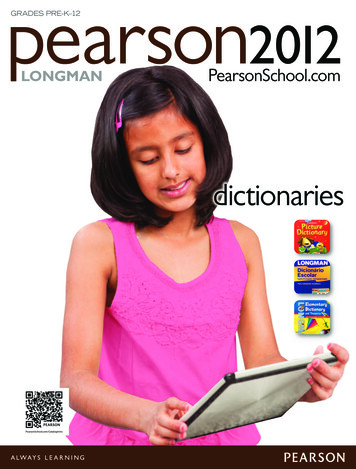
Transcription
Grades 3 to 5 Human Body SeriesSleepKidsHealth.org/classroomTeacher’s GuideYour eyelids are droopy, and you’re starting to yawn. What’s your body telling you?Sleep! The following activities will help your students understand the importance ofsleep and discover some interesting things that can happen while they sleep.This guide includes: Standards Related Links Discussion Questions Activities for StudentsRelated KidsHealth LinksArticles for Kids:What Sleep Is and Why All Kids Need It Reproducible MaterialsKidsHealth.org/en/kids/not-tired.htmlWhy Do I Need to at to Do if You Can’t SleepThis guide correlates withthe following National HealthEducation Standards:Students will: Comprehend concepts relatedto health promotion anddisease prevention to enhancehealth. Demonstrate the ability to useinterpersonal communicationskills to enhance health andavoid or reduce health risks. Demonstrate the ability touse decision-making skills toenhance health. Demonstrate the ability toadvocate for personal, family,and community walkingKidsHealth.org/en/kids/sleepwalking.htmlWhy Does My Body Jerk Before I Fall alth.org/en/kids/snoring.htmlDiscussion QuestionsNote: The following questions are written in language appropriate for sharing withyour students.1.Why is getting enough sleep every night so important for a healthy mindand body?2.What happens if kids don’t get enough sleep? How could getting enough sleephelp you do well in school?3.What are dreams and nightmares? What do you think causes them?4.What tips would you offer to a friend who’s having trouble getting a good night’ssleep?National Health EducationStandards: m 2015 The Nemours Foundation/KidsHealth. Reproduction permitted for individual classroom use.
Grades 3 to 5 Human Body SeriesSleepActivities for StudentsNote: The following activities are written in language appropriate for sharing with your students.My Sleep LogObjectives:Students will: Create a log to record their nightly sleep Analyze their sleep patterns Create a plan to improve sleep patterns if neededMaterials: “Sleep Log” handoutPencilClockClass Time:30 minutesActivity:Most kids need about 10 to 11 hours of sleep each night. Are you getting enough? Do you have healthy sleep habits?Create a sleep log to record information on how you sleep each night. Make sure you record what time you go tosleep, the number of hours you sleep, if you remember any dreams you had, and how you feel when you wake upin the morning. Continue recording this information at home for 1 week. Look at your log and determine if you gotenough sleep for the week. If not, what kept you from getting enough sleep? Create a plan to make sure you aregetting a good night’s sleep.Extensions:1.Describe and illustrate different dreams you’ve had. Add these descriptions and drawings to your sleep log.2.Continue recording the amount of sleep you get each night in your log for an entire month. Create a graph toshow your data. 2015 The Nemours Foundation/KidsHealth. Reproduction permitted for individual classroom use.
Grades 3 to 5 Human Body SeriesSleepHealthy Sleep HabitsObjective:Students will: Determine behaviors that encourage healthy sleep habitsMaterials: “Goodnight, Mia” handoutPencilClass Time:20 minutesActivity:Having a good bedtime routine can help a person get enough sleep. Help Mia decide what things will help her get agood night’s sleep and what things she should not do before going to bed.Extensions:1.Write a creative story about a girl or boy who could not sleep. What are some things that happened as a result?What are some things your character could do to solve his or her problem?2.What do you think is a good bedtime for kids your age? Write a persuasive letter to your parents explaining yourpoint of view.Reproducible MaterialsHandout: Sleep eep handout1.pdfHandout: Goodnight, eep handout2.pdfQuiz: sleep quiz.pdfAnswer Key: sleep quiz answers.pdfKidsHealth.org is devoted to providing the latest children’s health information. The site, which is widelyrecommended by educators, libraries, and school associations, has received the “Teachers’ Choice Awardfor the Family” and the prestigious Pirelli Award for “Best Educational Media for Students.” KidsHealth comesfrom the nonprofit Nemours Foundation. Check out www.KidsHealth.org to see the latest additions! 2015 The Nemours Foundation/KidsHealth. Reproduction permitted for individual classroom use.
Name:Human Body SeriesSleepDate:Instructions: Fill out this log for 1 week. Then, look at the day or days when you didn’t get enough sleep or felt tired during the day. What could you do to get a better night’srest every night?DAY1DAYDAY23DAY4DAY5DAY6DAY7Yesterday, I exercised for this many minutes:Yesterday, I: (check all that apply)Ate too muchDidn’t eat enoughHad a drink with caffeine, like soda or tea Sleep LogYesterday, I: (check one)Had lots of energyWas tired all dayFelt sleepy in the afternoonYesterday, I took a nap. (check one)TrueFalseLast night, I went to bed at this time: Last night, I fell asleep at this time:Today, I woke up at this time:Last night, I slept for this many hours: 2015 The Nemours Foundation/KidsHealth. Reproduction permitted for individual classroom use.
Name:Human Body SeriesSleepDate:Goodnight, MiaInstructions: Help Mia decide which things are healthy sleep habits and which aren’t. Circle the healthy sleep habits and put an X next to things that Mia should not do.Drink a sodabefore going to bed.Sleep in a dark room.Sleep with pets.Take a bath before bedtime.Read a bookbefore goingto sleep.Watch ascary movie.Write in ajournal to clearher mind beforegoing to sleep.Go to bedat the sametime each night.Go for a walk before bedtime. 2015 The Nemours Foundation/KidsHealth. Reproduction permitted for individual classroom use.
Human Body SeriesSleepName: Date:QuizInstructions: Answer each question.1.True or false: Schoolwork can be harder for students who don’t get enough sleep each night.2.The R.E.M. stage of sleep is when people dream. You can tell if someone is in this sleep stage by looking at their closedeyelids. R.E.M. stands for.3.Kids who are between 5 and 12 years old need to sleep this long to feel refreshed and ready to learn the next day:a) 7 to 8 hoursb) 8 to 9 hoursc) 9 to 10 hoursd) 10 to 11 hours4.True or false: A dark, quiet bedroom at a comfortable temperature can make it difficult to fall asleep.5.If you can’t sleep because you’re worried, scared, stressed out, or having problems with something, it can help to talk with. 2015 The Nemours Foundation/KidsHealth. Reproduction permitted for individual classroom use.
Human Body SeriesSleepAnswer Key1.True or false: Schoolwork can be harder for students who don’t get enough sleep each night.2.The R.E.M. stage of sleep is when people dream. You can tell if someone is in this sleep stage by looking at their closedeyelids. R.E.M. stands forrapid eye movement.3.Kids who are between 5 and 12 years old need to sleep this long to feel refreshed and ready to learn the next day:a) 7 to 8 hoursb) 8 to 9 hoursc) 9 to 10 hoursd) 10 to 11 hours4.True or false: A dark, quiet bedroom at a comfortable temperature can make it difficult to fall asleep.5.If you can’t sleep because you’re worried, scared, stressed out, or having problems with something, it can help to talk with(any of the following: an adult, a parent, a teacher, a counselor, a psychologist). 2015 The Nemours Foundation/KidsHealth. Reproduction permitted for individual classroom use.
Create a sleep log to record information on how you sleep each night. Make sure you record what time you go to sleep, the number of hours you sleep, if you remember any dreams you had, and how you feel when you wake up in the morning. Continue recording this information at home for 1 week. L

